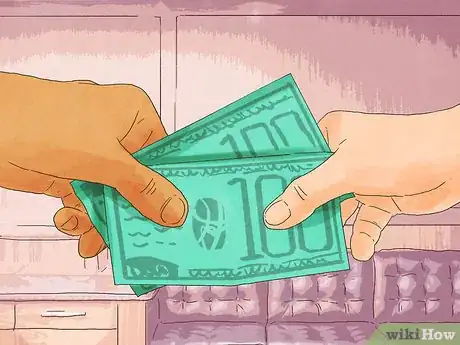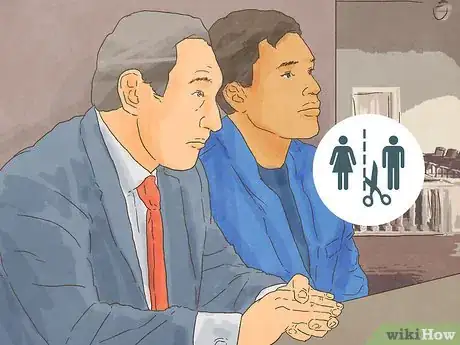This article was co-authored by Lahaina Araneta, JD. Lahaina Araneta, Esq. is an Immigration Attorney for Orange County, California with over 6 years of experience. She received her JD from Loyola Law School in 2012. In law school, she participated in the immigrant justice practicum and served as a volunteer with several nonprofit agencies.
There are 9 references cited in this article, which can be found at the bottom of the page.
This article has been viewed 48,341 times.
Marriages don’t work out for a variety of reasons. To apply for a divorce in New York, you’ll need to complete and file forms with the court in the county where you live. However, if your spouse contests the divorce, then you should probably consult with an attorney.
Steps
Completing Paperwork
-
1Satisfy the residency requirement. Only people with a substantial connection to New York can get divorced here. You must meet one of the following requirements:[1]
- Either you or your spouse has lived in New York for two continuous years before you start the divorce.
- Either you or your spouse has been living in New York for at least one year and you were married in New York or you lived in New York as a married couple.
- Either spouse has lived in New York for one year and the grounds for divorce occurred in New York.
- Both spouses live in New York on the day you start the divorce and the grounds for your divorce happened in the state.
-
2Fill out your paperwork for an uncontested divorce. If you’re getting an uncontested divorce, you can complete paperwork at the New York Courts website: https://www.nycourts.gov/courthelp/family/divorceStarting.shtml.
- An uncontested divorce is one where you and your spouse agree to get divorced and agree on child custody, child support, alimony, and the division of marital property and debts.[2] If you disagree about any one of these, then you don’t have an uncontested divorce.
- You might not know if your divorce is contested or not. Talk to your spouse ahead of time. In any event, you can file for an uncontested divorce initially, and then you’ll go ahead with a contested divorce if your spouse disagrees.
Advertisement -
3Hire a divorce lawyer for a contested divorce. Don’t use the forms at the New York Courts website if you and your spouse can’t agree on all aspects of the divorce. Instead, you should work with a New York divorce lawyer. Obtain a referral from the New York bar association by calling 1-800-342-3661.[3]
- If money is tight, visit the lawhelp.org website to find low-cost legal help.
-
4Identify the reason for the divorce. In your paperwork, you must give a reason why the marriage has ended. This is called the “grounds” for the divorce. In New York, there are several possible grounds. Choose among the following:[4]
- Irretrievable breakdown for at least six months. Basically, this is the “no fault divorce” option. Your relationship must have been over for at least six months before you file.
- Cruel and inhuman treatment. Over the past five years, your spouse must have endangered you physically or mentally. Merely disagreeing a lot isn’t enough.
- Abandonment. Your spouse has left you for at least a year. Refusing to have sex with you for a year also qualifies as abandonment.
- Imprisonment. Your spouse has been in prison for three years in a row.
- Adultery. Your spouse committed adultery during the marriage. You’ll need solid evidence, such as testimony from the person your spouse has slept with.
- Other reasons. If you want, you could get legally separated for a year and then qualify for a divorce. However, if you want to divorce more quickly, then choose a different ground.
Filing Your Papers
-
1Visit your local court. Go to the court in your county. In New York, this court is called the Supreme Court, and it is the only one that can grant you a divorce. You’ll file at the court clerk’s office.[5]
- In some counties, you can file your papers electronically. This is a good option if you are comfortable with technology. Visit https://iapps.courts.state.ny.us/nyscef/AuthorizeCaseType to check if your county court has been approved for e-filing.
- If you hired a lawyer, they will take care of filing your papers and serving copies on your spouse.
-
2File your summons. You’ll need to file your Summons With Notice or your Summons and Complaint with the court clerk. If you have a settlement agreement, then you should file that at the same time.[6]
-
3Pay fees. You’ll need to pay $210 to get an index number — known as a "case number" in most other states — to start the case. Call ahead of time to check what methods of payment are acceptable.
- Later on, you will have to pay additional fees. An uncontested divorce will cost at least $335, and a contested divorce will cost more. If you can’t afford the fee, complete a fee waiver form.[7]
Serving Your Spouse
-
1Gather your paperwork. You must provide your spouse photocopies of many different forms. This notice is necessary so your spouse can respond to your allegations and possibly contest the divorce. Make copies of the following and write the index number at the top of each:[8]
- Summons With Notice or Summons and Verified Complaint
- Notice of Automatic Order
- Notice Concerning Continuation of Health Care Coverage
- Sworn Statement of Removal of Barriers to Remarriage
-
2Deliver the papers yourself in an uncontested divorce. Talk to your spouse and ask if they will contest the divorce. If not, you can go ahead and give your spouse the divorce papers. They must also sign their Affidavit of Defendant and have it notarized.[9]
-
3Arrange service in all other situations. Unless you are 100% sure your spouse won’t contest the divorce, you should arrange for the papers to be personally served by someone else. You must meet the following conditions for your service to be proper:[10]
- Serve the papers within 120 days of filing them with the county clerk. There’s probably no reason to wait.
- Your server must be at least 18 years old and must be a New York state resident.
- If you’re serving papers outside New York, then the server must be a New York resident or someone legally allowed to serve papers in the state.
-
4File the affidavit of service. Whoever serves papers must complete this affidavit and return it to you. The affidavit serves as proof that the papers were served. File it with the court.[11]
-
5Continue on with your case. Your spouse will have a chance to respond. How they respond will determine the next steps you must take:[12]
- If your spouse signs and returns the Affidavit of Defendant, then you should go to the court clerk’s office and ask to have your case put on the calendar. The Affidavit of Defendant is where the defendant will agree to the divorce and all of the conditions listed in the Summons with Notice. It is only used in an uncontested divorce.
- If your spouse files a Notice of Appearance instead, then you will have a contested divorce. You might need to hire a lawyer if you don’t already have one.
- If your spouse doesn’t respond at all, you can put your case on the court calendar and ask for a default divorce.
Expert Q&A
-
QuestionWhat if my children and I have border protection in place for domestic violence?
 Lahaina Araneta, JDLahaina Araneta, Esq. is an Immigration Attorney for Orange County, California with over 6 years of experience. She received her JD from Loyola Law School in 2012. In law school, she participated in the immigrant justice practicum and served as a volunteer with several nonprofit agencies.
Lahaina Araneta, JDLahaina Araneta, Esq. is an Immigration Attorney for Orange County, California with over 6 years of experience. She received her JD from Loyola Law School in 2012. In law school, she participated in the immigrant justice practicum and served as a volunteer with several nonprofit agencies.
Attorney at Law This will be read and evaluated by the judge in your case and they will see how that affects custody with your spouse.
This will be read and evaluated by the judge in your case and they will see how that affects custody with your spouse.
References
- ↑ https://www.nycourts.gov/courthelp/family/divorceRequirements.shtml
- ↑ https://www.nycourts.gov/divorce/divorce_withchildrenunder21.shtml
- ↑ https://www.nycourts.gov/divorce/forms.shtml#Statewide
- ↑ https://www.nycourts.gov/courthelp/family/divorceRequirements.shtml
- ↑ https://www.nycourts.gov/courthelp/family/divorceStarting.shtml
- ↑ https://www.nycourts.gov/courthelp/family/divorceStarting.shtml
- ↑ https://www.nycourts.gov/courthelp/family/divorceStarting.shtml
- ↑ https://www.nycourts.gov/courthelp/family/divorceService.shtml
- ↑ https://www.nycourts.gov/courthelp/family/divorceService.shtml




































































